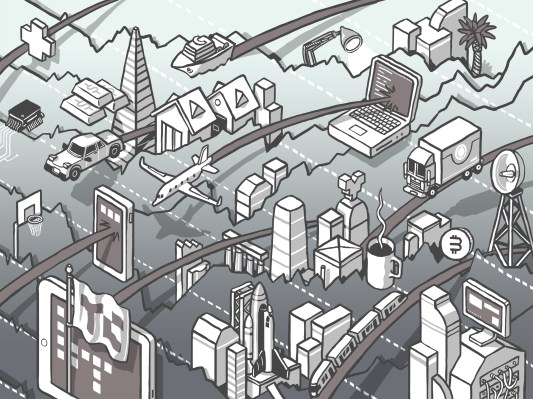With record venture capital totals, record numbers of startups worth $1 billion or more and eye-watering revenue multiples available for private and public technology companies alike, you could be forgiven for having concern that we’re heading for a dot-com-style correction.
The believers are not convinced. And for good reason, it turns out.
The Exchange explores startups, markets and money.
Read it every morning on TechCrunch+ or get The Exchange newsletter every Saturday.
It is always risky to say it’s different this time, but today’s technology boom and the dot-com rush are, in fact, rather different. In the dot-com period, companies with little to no revenue went public at titanic valuations, leading to a simply massive accretion of risk in the public markets. Regular folks wound up exposed to that risk and were burned when the winds shifted and tech valuations plummeted.
 It’s entirely fair to say that most tech upstarts today that are richly valued are far less revenue-free than their dot-com forefathers.
It’s entirely fair to say that most tech upstarts today that are richly valued are far less revenue-free than their dot-com forefathers.
But while it has been fair to say that risks have been contained by company quality — the existence of revenue and the shock-dampening effect of strong revenue multiples for technology concerns, broadly — we’ve seen a steady erosion of the argument in recent quarters. Even more, we’re seeing the quality of tech companies that go public at times decline, leading to more risk available to consumer investors — not just the professionals.
Revenue-lite becomes revenue-free
There are two vectors that underpin the argument that inherent risk in today’s rich technology valuations is not a concern. The first is that the valuations in question are not built on air. The second is that the public is not directly exposed to high-risk companies:
- Startup valuations are not a concern because the public cannot get involved in companies that could yet go poof, and the companies in question have real revenues.
- Public tech valuations are not a concern because although the public can get involved in their ownership, the prices of public tech companies are predicated on material revenues.
Cool.
But the arguments above are being swiftly eroded by market dynamics that are pumping more risk into both the private and public markets. More simply, the public is increasingly able to invest in higher-risk tech companies, and as multiples rise, the amount of air that tech valuations sit upon is expanding.
The public is now at risk.
On the private side of the market, the public remains generally protected. Thanks to U.S. securities law, most folks here cannot get their money into nascent tech companies. Crowdfunding isn’t a huge risk to the public because it typically involves small-dollar investments that add up to a tiny percentage of the overall dollars flowing to still-private companies.
However, the public’s money is invested into funds that are busy putting more dollars, more quickly into startups — and they are doing so at higher prices for less-profitable shares, as we discussed recently.
Still, the public’s risk is more easily appreciated in the public markets, where we are seeing private-market enthusiasm become public-market reality. A few examples:
- MetroMile raised lots of money as a startup. It eventually went public via a SPAC. It then lost most of its enterprise value before being mercy-killed by Lemonade this week. If its private backers sold their shares, they perhaps got out at a profit. The investing public likely took a bath, given the company’s share price trajectory.
- Rivian — a company that managed to build 12 cars in the last quarter and deliver 11 — went public this week. Its valuation? Per Yahoo Finance data, $98.7 billion. The investing public can get exposure now to a company that reads like a dot-com story that hasn’t yet written its ending.
Sure, MetroMile could be an outlier. And Rivian may wind up building real numbers of cars, growing into at least a material fraction of its implied future revenue — and gross profit — scale. But that doesn’t mean that we aren’t seeing examples of expanded risk finding an increasingly public footprint.
Currently, folks busy investing in the private tech market aren’t that concerned. Why would they be? Tech valuations are near all-time highs and there is infinite money to put to work. They look like geniuses, bidding up one another’s investments, apparently full of the belief that tech multiples have reached a new, higher and permanent plateau.
And so, the most enthusiastic tech backers are willing to pay more than ever for startup shares. I keep hearing about multiples from private-market tech companies’ recent rounds that are treading around 100x — or greater. These deals make sense on paper given that there’s always another private investor to provide a markup in a subsequent deal, or, critically, the chance to offload startups to the public market, which is willing to pay top dollar for yet-unprofitable tech companies.
Private investors are putting many tech startups in a position where they have to chase similar, elevated multiples over the next half-decade or so, regardless of market conditions — perhaps even when they do go public. This could lead to more IPOs in which a company’s revenue base and expected valuation have a yawning gap between them. And that could put even more risk into the public’s hands.
Yes, companies in the late unicorn era are of better quality than what we saw in the dot-com boom. But as more capital flows in, what was once rich pricing is at times becoming fantasy pricing, and — thanks to a SPAC boom pushing lower-quality companies into the public sphere coupled with a more active IPO cycle often involving expensive former startups — regular folks are getting in on the game. And that’s just risky.
